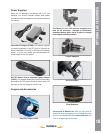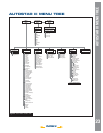
INDEX
“9/Display” – Toggles video output between
on/off.
“0/Mode” – This key lets you cycle through the
telescope’s modes, (See the entry above).
ᕧ Scroll Keys: Accesses options within a selected
menu. The menu is displayed on the fi rst line of
the screen. Options within the menu are displayed,
one at a time, on the second line. Press the Scroll
keys to move through the options. Press and hold
a Scroll key to move quickly through the options.
When entering data, the Scroll Down key and
the Down Arrow key move forward through the
alphabet & digits (A to Z, 0 to 9). The Scroll Up
key and the Up Arrow key move backward (Z to
A, 9 to 0). Common symbols are also available in
the list.
ᕨ “MEDIA” Key: The media key lets you toggle help
and audio/video descriptions on and off. At any
time you are navigating the menus, pressing the
Media Key will start an explanation of the menu’s
function. If you have selected an object, pressing
the media key, will tell you more about the object.
If a media clip is playing, pressing “MEDIA” stops
the media clip and moves you back to the menu
or object display.
ᕩ Coil Cord Port: Plug one end of the AutoStar coil
cord into this port (Pg. 19. Fig. 5, 9) located at the
bottom of the AutoStar handbox.
µ Coil Cord: Plug one end of the AutoStar coil cord
into the HNDBX port (Pg. 12, Fig. 4, 23) of the
input/output panel of the telescope and the other
end into the coil cord port (Fig. 5, 9).
AUTOSTAR III HANDBOX
LS TIPS
Observing Considerations
• Try to pick an observing site away from street
and house lights and car headlights. While
this is not always possible, the darker the site,
the better.
• Try not to use a standard fl ashlight.
Experienced observers use red LED
fl ashlights, the red utility light on the AutoStar
III handbox, or tape red cellophane over their
fl ashlights to use for setup and map reading
so they don’t have to continually readjust
their eyes to the darkness. Be careful not to
shine bright lights if there are other observers
in the area. Do not shine a fl ashlight into the
telescope while someone is observing!
• Dress warmly. It gets chilly when you’re sitting
for prolonged periods.
• Practice setting up your equipment during the
day or in a lighted area to become familiar
with it before going to a dark site.
• Use your 26mm eyepiece to view terrestrial
objects and wider areas of space, such as
open star clusters. Use optional higher power
eyepieces, such as a 9mm eyepiece, when
you wish to view something up close, such as
craters on the Moon or the rings of Saturn.
22
Orion Nebula (M42)


















